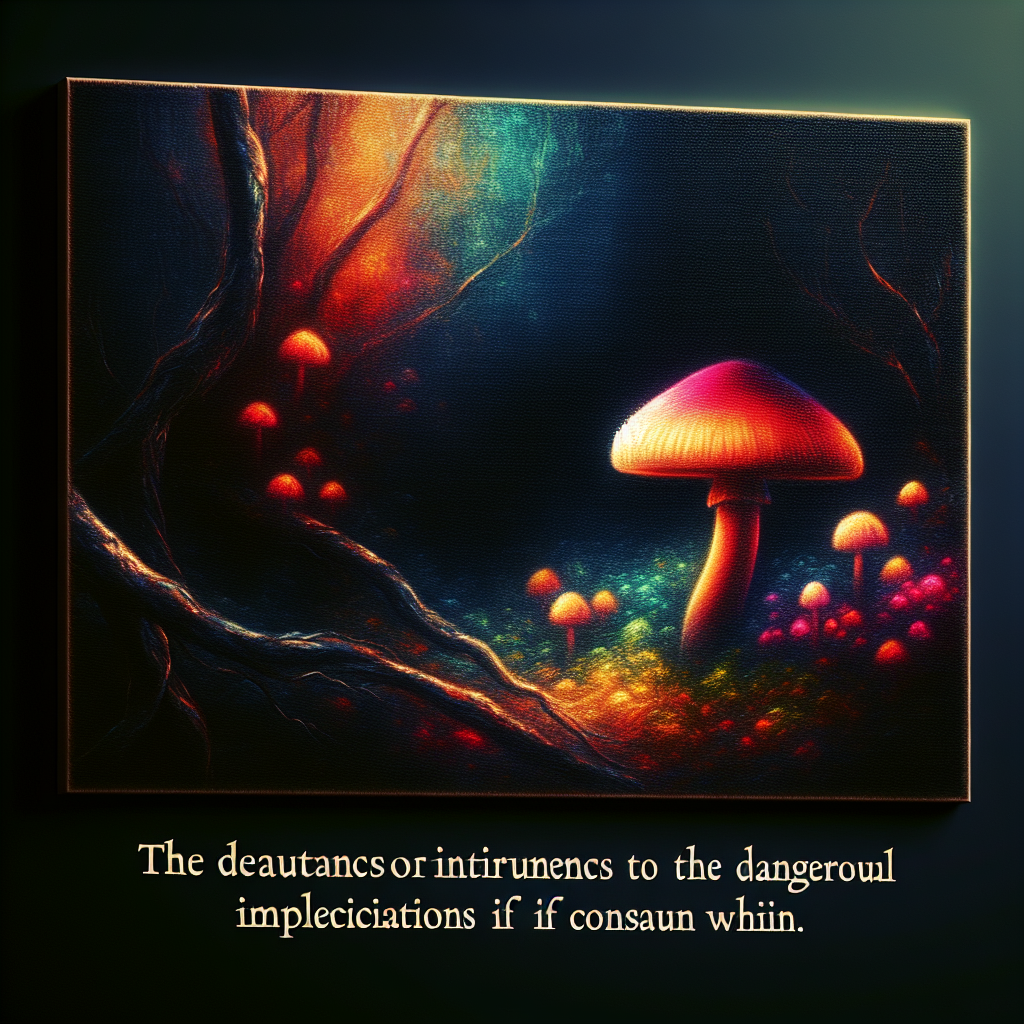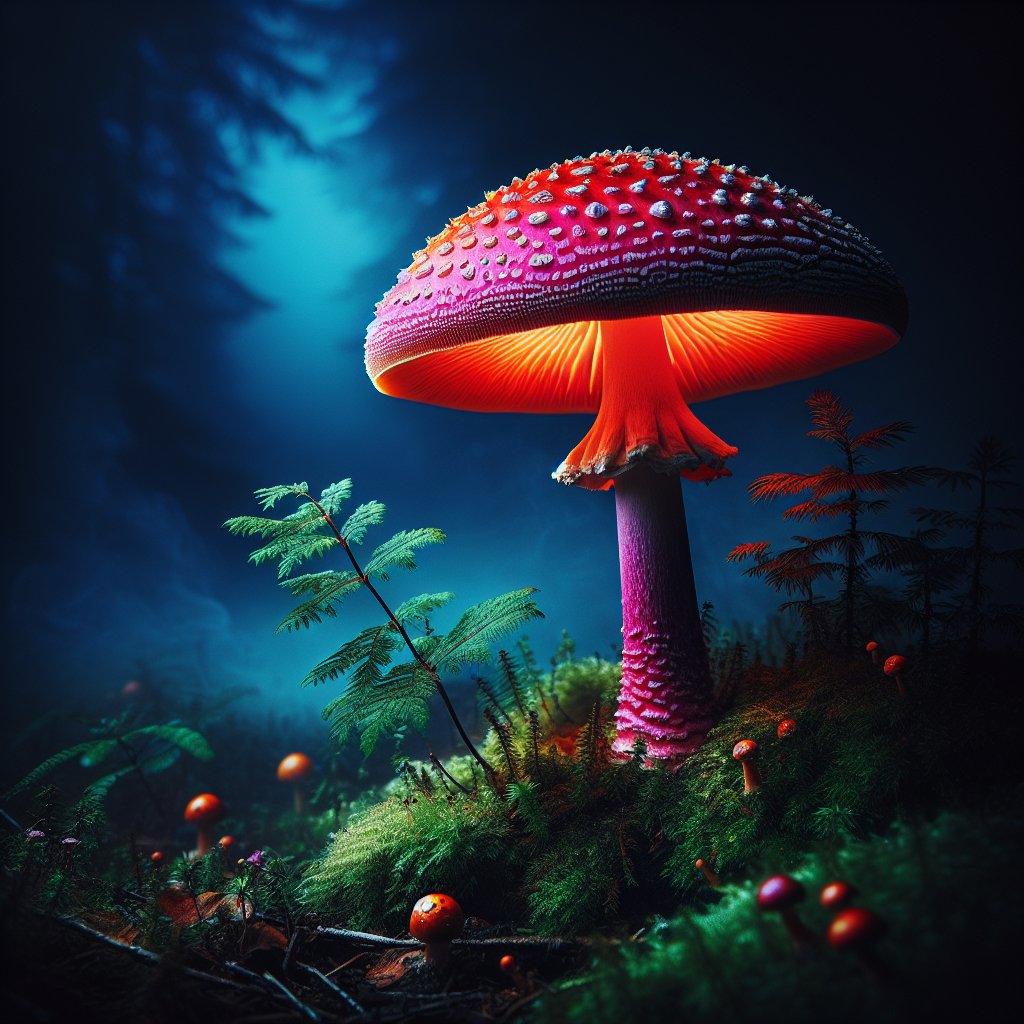Have you ever wondered if there are any mushrooms out there that can be deadly if consumed? In this article, we will explore the fascinating world of poisonous mushrooms and shed light on whether or not there are any varieties that can be truly fatal. You’ll be amazed by the array of colors, shapes, and sizes these fungi come in, but also learn about the importance of caution when foraging for mushrooms in the wild. So, let’s embark on this journey and discover the truth about poisonous mushrooms that could potentially pose a serious threat if ingested.
Types of Toxic Mushrooms
Amanita Phalloides
The Amanita Phalloides, also known as the Death Cap, is one of the most deadly poisonous mushrooms out there. It is often mistaken for edible varieties due to its appearance. This mushroom can be found in North America and Europe, predominantly growing in association with trees such as oaks or birches. It is most commonly found in late summer and fall.
Gyromitra esculenta
The Gyromitra esculenta, commonly known as the False Morel, is another toxic mushroom that can be lethal if ingested. This mushroom looks similar to the edible Morel mushroom, but it has a distinct wrinkle-like cap. It can be found in North America and Europe, usually in coniferous forests, from spring to early summer.
Clitocybe dealbata
The Clitocybe dealbata, also known as the Leathy Clitocybe or Fool’s Funnel, is a poisonous mushroom that grows in grassy areas or woodlands. It is commonly found in Europe and North America. This mushroom carries toxins that can cause severe symptoms if consumed.
Conocybe filaris
The Conocybe filaris, commonly referred to as the Deadly Conocybe, is a small mushroom that can be found in North America. It typically grows in lawns, gardens, and parks, often appearing in the late summer or early fall. While its small size may make it easy to overlook, this mushroom can be extremely dangerous if eaten.
Galerina marginata
The Galerina marginata, also known as the Autumn Skullcap, is a mushroom that is widespread and can be found in North America, Europe, and Asia. It is commonly found in wooded areas, growing on decaying wood or buried wood fragments. Despite its small size and unassuming appearance, this mushroom contains toxins that can have severe effects on the human body.
Symptoms of Mushroom Poisoning
When someone ingests toxic mushrooms, they can experience various symptoms. These symptoms can be categorized into gastrointestinal, neurological, and hepatic symptoms. It is crucial to recognize these symptoms to seek immediate medical attention.
Gastrointestinal symptoms
Gastrointestinal symptoms include nausea, vomiting, diarrhea, and abdominal pain. These symptoms typically manifest within a few hours of mushroom ingestion and are usually the first signs of toxicity. In severe cases, these symptoms can progress rapidly and lead to dehydration and electrolyte imbalances.
Neurological symptoms
Neurological symptoms can range from mild to severe. They may include confusion, hallucinations, dizziness, seizures, and loss of coordination. In some cases, these symptoms can lead to coma or even death if left untreated.
Hepatic symptoms
Hepatic symptoms primarily affect the liver and can include jaundice (yellowing of the skin and eyes), dark urine, and elevated liver enzymes. Severe liver damage can occur in some cases, leading to liver failure and the need for a liver transplant.

Amanita Phalloides (Death Cap)
Description and habitat
The Amanita Phalloides, commonly known as the Death Cap, is a deadly mushroom found in various parts of the world, including North America and Europe. It typically grows in association with trees, such as oaks, beeches, and chestnuts. The Death Cap has a distinctive appearance, with a greenish-yellow to olive-colored cap, white gills, and a bulbous base called a volva.
Toxic components
The Death Cap contains amatoxins, which are a group of toxins that primarily affect the liver and kidneys. These toxins inhibit protein synthesis, leading to organ failure if left untreated.
Symptoms and effects
Ingesting the Death Cap can lead to severe gastrointestinal symptoms, typically appearing within 6-12 hours after consumption. These symptoms are followed by a brief period of apparent recovery, misleading the person into thinking they are fine. However, within 24-48 hours, the toxins start affecting the liver and kidneys, causing jaundice, kidney failure, and potentially death.
Treatment and prognosis
Immediate medical attention is crucial in cases of Amanita Phalloides poisoning. Treatment often involves aggressive supportive care, such as intravenous fluids, pain management, and monitoring of liver and kidney function. In severe cases, a liver transplant may be necessary. The prognosis depends on the promptness of medical intervention and the extent of organ damage.
Gyromitra esculenta (False Morel)
Description and habitat
The Gyromitra esculenta, also known as the False Morel, is a toxic mushroom that resembles the edible Morel mushroom. It has a distinctive cap with a wrinkled, brain-like appearance. This mushroom can be found in North America and Europe, particularly in coniferous forests during the spring and early summer.
Toxic components
The False Morel contains gyromitrin, a volatile compound that converts into monomethylhydrazine (MMH) when ingested. MMH is a toxin that affects the central nervous system and can lead to various neurological symptoms.
Symptoms and effects
Consuming the False Morel can result in gastrointestinal symptoms similar to other toxic mushrooms. However, the most concerning effects are related to its neurotoxicity. Neurological symptoms can range from mild dizziness and confusion to seizures and loss of consciousness. Severe cases can lead to respiratory failure and potentially be life-threatening.
Treatment and prognosis
There is no specific antidote for gyromitrin poisoning. Treatment focuses on supportive care, managing symptoms, and monitoring the patient closely. In severe cases, patients may require respiratory support and stabilization. The prognosis depends on the severity of the poisoning and the promptness of medical intervention.

Clitocybe dealbata (Leathy Clitocybe)
Description and habitat
The Clitocybe dealbata, also called the Leathy Clitocybe or Fool’s Funnel, is a toxic mushroom found in Europe and North America. It typically grows in grassy areas, meadows, or woodlands. This mushroom has a funnel-shaped cap with a pale color, and its flesh turns yellow when bruised.
Toxic components
The main toxin in the Clitocybe dealbata is muscarine, a compound that affects the nervous system. Muscarine is also found in certain poisonous plants, such as deadly nightshade.
Symptoms and effects
Ingesting the Leathy Clitocybe can result in gastrointestinal symptoms, similar to other toxic mushrooms. However, the distinguishing feature of muscarine poisoning is the onset of cholinergic symptoms. These symptoms can include excessive sweating, salivation, tearing, blurred vision, difficulty focusing, and even respiratory distress.
Treatment and prognosis
Treatment primarily involves supportive care and managing symptoms. In severe cases, medications may be administered to counteract the effects of muscarine. Prognosis is generally good, but it depends on the promptness of medical intervention.
Conocybe filaris (Deadly Conocybe)
Description and habitat
The Conocybe filaris, also known as the Deadly Conocybe, is a small but deadly mushroom found in North America. It typically grows in lawns, gardens, and parks, often appearing in late summer or early fall. This mushroom has a bell-shaped cap with a pale to yellowish-brown color.
Toxic components
The Deadly Conocybe contains amatoxins, similar to the Amanita Phalloides. These toxins have a destructive effect on the liver and kidneys, often leading to fatal consequences if ingested.
Symptoms and effects
Consuming the Deadly Conocybe can cause gastrointestinal symptoms, followed by the onset of severe liver damage within hours. If left untreated, liver failure can occur, leading to potentially fatal consequences.
Treatment and prognosis
Treatment for Conocybe filaris poisoning is similar to Amanita Phalloides poisoning, involving aggressive supportive care and close monitoring of liver and kidney function. The prognosis depends on the promptness of medical intervention.
Galerina marginata (Autumn Skullcap)
Description and habitat
The Galerina marginata, commonly known as the Autumn Skullcap, is a mushroom found in North America, Europe, and Asia. It typically grows on decaying wood or buried wood fragments in wooded areas. This mushroom has a small, slimy cap with a brownish color.
Toxic components
The Autumn Skullcap contains the same amatoxins found in the Amanita Phalloides and Conocybe filaris. These toxins can cause significant damage to the liver and other organs.
Symptoms and effects
Ingesting the Autumn Skullcap can lead to gastrointestinal symptoms, followed by the onset of liver damage within a few days. Severe cases can result in liver failure and potential fatality.
Treatment and prognosis
Immediate medical attention is crucial in cases of Autumn Skullcap poisoning. Treatment focuses on supportive care and monitoring organ function. The prognosis depends on the promptness of medical intervention and the extent of organ damage.
Other Lethal Mushrooms
Apart from the discussed toxic mushrooms, several other varieties pose a significant risk to human health. These include:
Amanita Ocreata (Western Destroying Angel)
Amanita Virosa (Destroying Angel)
Gyromitra caroliniana (Big Red False Morel)
Inocybe spp. (Fibrous Caps)
Each of these mushrooms has its unique characteristics, toxic components, symptoms, and effects. It is crucial to familiarize oneself with these dangerous varieties to prevent accidental ingestion.
Mushroom Poisoning Diagnosis
Diagnosing mushroom poisoning involves considering the patient’s clinical history, symptoms, and potential exposure to toxic mushrooms. Prompt identification of the consumed mushrooms can also aid in the diagnosis and choice of treatment.
Clinical history and symptoms
Detailed information about the time of ingestion, quantity consumed, and any associated symptoms is essential in making an accurate diagnosis. The onset and progression of symptoms can vary depending on the type of mushroom ingested.
Identification of mushrooms
If possible, collecting and identifying the consumed mushrooms can be a crucial step in diagnosis. This requires knowledge of mycology or consulting an expert, as misidentification can lead to potentially dangerous consequences.
Laboratory tests
In cases where mushroom identification is not possible, laboratory tests can help determine the presence of toxins in the body. Blood and urine tests may be performed to analyze liver and kidney function and detect specific toxins.
Conclusion
Mushroom poisoning can have severe consequences, and it is essential to be aware of the types of toxic mushrooms and their associated symptoms. Amanita Phalloides, Gyromitra esculenta, Clitocybe dealbata, Conocybe filaris, and Galerina marginata are just a few examples of highly toxic mushrooms that can be lethal if ingested. Prompt identification, seeking medical attention, and supportive care are crucial in mitigating the effects of mushroom poisoning. Remember, when it comes to mushrooms, it is always better to err on the side of caution and seek guidance from experts in mycology.



No Responses